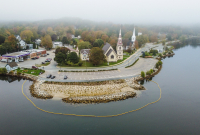Support strong Canadian climate journalism for 2025
“There really wasn't a scrap of insulation in the place when we bought it,” architect Lorrie Rand says of the 1850s North End house on Falkland Street purchased by Habit Studio, a women-led architectural and residential home design firm.
“There was a pile of gravel on the basement floor, water on the stone walls, and single-glazed windows with the original frames … of course, no longer with the original glass,” she says.
But there was history.
“When we started the renovations, we found a letter in a wall written in Yiddish from the turn of the century,” explains Rand. “And another letter written by a soldier in WW II who was recovering in a hospital explaining to his girlfriend why they had to break up.”
Historic though the timber-frame, two-storey building may be, energy efficient it was not.
“When we did our first energy-efficiency blower door test, the results were almost as if you’d set up the test outside somewhere and just let it run,” says Rand. “This was a difficult — and very expensive — home to heat.”

That’s why Habit Studio, which plans to make the renovated building the headquarters for the seven-member team, is in the midst of an extensive retrofit. They have an ambitious goal of reducing the total energy use of the building by over 85 per cent. They also expect the building to be 60 per cent more efficient than the minimum required for a retrofit using the current building codes.
The retrofit is a clear reflection of Habit Studio values — which boasts over 20 years of experience in green building design.
“As a firm, we take our responsibility for the future of our planet very seriously,” says Rand. “We want to demonstrate that it is possible to retrofit an aging structure, transforming it into a space that is sustainable, resilient, energy efficient — and comfortable.”
And they want the Falkland Street house to not only be highly energy efficient but also Nova Scotia’s first Passive House retrofit. Passive House is a concept originating with the Passive House Institute of Germany: a high-performance building standard that strives for low-carbon, energy-efficient buildings. The Passive House Institute recognizes that many older buildings cannot achieve the performance targets set for new construction, so they have standards tailored specifically to the renovation of older homes.
Building improvements include improved insulation, air tightening, improved ventilation with highly efficient heat recovery, and the use of high-performance windows and doors. Habit will also install a heat pump and supplemental electric heat in some rooms.
Once complete, Rand expects to have reduced the building’s greenhouse gas emissions by over 85 per cent.
“We’ve designed Passive House buildings before, but this is our first Passive House retrofit, and it’s definitely a bigger challenge,” she says. “Maybe some people think we’re crazy to try to renovate to the Passive House standard, especially because you can’t do things like re-orient the building to maximize the sun, but we want to showcase what you can do with deep retrofits to save a lot of energy and reduce GHG emissions.”
Seamus McGrail, a senior heritage planner with Halifax Regional Municipality, hopes the project will encourage more retrofits that balance the unique value of older homes with climate action.

“Something we hear quite often is that an older home just can’t be brought up close to the energy efficiency standards of a new build,” McGrail says. “We need to change this perception, and I think projects like this one will be a case study for positive change.”
McGrail also speaks to the fact that we need to start “acknowledging the embodied carbon costs of entirely new builds.” (Embodied carbon refers to the greenhouse gas emissions produced in the manufacturing, transportation, installation, and disposal of building materials.) McGrail says that by retrofitting old buildings, it’s possible to preserve existing materials while also preventing waste from going into our landfills.
There is the environmental cost of doing — or not doing — energy-efficiency upgrades. There are also the hard cash costs. It may seem expensive to retrofit an older building, but Rand stresses that the savings over the long term and the fact that any home will eventually need some repairs and replacements means that the extra investment in better windows, insulation, air sealing, and high-quality ventilation is well worth it in the long run.
“Once the building is more energy efficient and robust, you can put in the smallest heating system you need to produce the reduced heat you’ll need to keep you warm,” says Rand.
“You have to replace your furnace and other mechanicals at some point anyway, so do it with the future in mind. Great insulation and great windows pay for themselves.”
The pandemic slowed down the retrofits, and the narrow North End street can sometimes make the delivery of materials a logistical nightmare, but Rand and the Habit Studios team are excited about how their new office is shaping up.
“It’s our bucket list project and once complete, people will be able to go and experience a Passive House, feel the level of comfort and understand the level of efficiency.”
This story is being shared by the Climate Story Network, an initiative of Climate Focus, a non-profit organization dedicated to covering stories about community climate solutions.





Comments